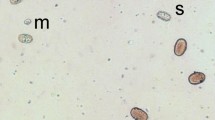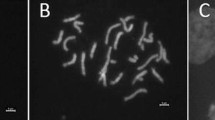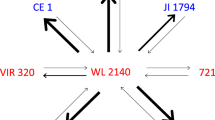Abstract
Most forage cultivars released for the genus Paspalum belong to a section named Plicatula. The species of Plicatula are mostly apomictic and consequently the genetic diversity is locked for their genetic improvement. The objectives were to evaluate the crossability, hybrid fertility, heterosis, and genetic distances between apomictic accessions and a sexual genotype of species of Plicatula group of Paspalum. Crosses were made using 22 apomictic tetraploid accessions belonging to 12 different species as pollen donors, and a sexual tetraploid genotype induced by colchicine from a sexual diploid accession of P. plicatulum. Crossability varied between 0 and 16% among crosses. Viable hybrid offspring were recovered from 15 out of 22 crosses. The most successful crosses involved P. guenoarum, P. plicatulum, P. chaseanum, and P. oteroi. Fertility of the sampled hybrids varied between 1.6% for the cross involving P. lenticulare, and 40.1% for an intraspecific cross (P. plicatulum, accession Hojs388). The genetic distance between parents was estimated using amplified fragment-length polymorphism, and it varied between 0.34 and 0.53. There was no correlation between genetic distances and crossability or fertility of the hybrids. Hybrids from the most numerous families were classified for mode of reproduction using flow cytometric seed analysis. The ratio between sexual and apomictic hybrids varied between 0.6:1 and 1.6:1. A selected group of apomictic hybrids were evaluated for several agronomic traits in the field. Heterosis was observed for frost tolerance and cattle preference. The results indicated that gene transfer via hybridization is possible among several species of Plicatula. Superior hybrids for specific traits can be generated and fixed by apomixis.


Similar content being viewed by others
References
Acuña CA, Blount AR, Quesenberry KH, Kenworthy KE, Hanna WW (2011) Tetraploid bahiagrass hybrids: breeding technique, genetic variability and proportion of heterotic hybrids. Euphytica 179:227–235
Aguilera PM, Sartor ME, Galdeano F, Espinoza F, Quarin CL (2011) Interspecific tetraploid hybrids between two forage grass species: sexual Paspalum plicatulum and apomictic P. guenoarum. Crop Sci 51:1544–1550
Aguilera PM, Galdeano F, Quarin CL, Ortiz JPA, Espinoza F (2015) Inheritance of aposporous apomixis in interspecific hybrids derived from sexual Paspalum plicatulum and apomictic Paspalum guenoarum. Crop Sci 55:1947–1956
Balzarini M, Di Rienzo J (2004) Info-Gen: software para análisis estadístico de datos genéticos. Facultad de Ciencias Agropecuarias. Universidad Nacional de Córdoba, Argentina
Bashaw EC (1968) Registration of Higgins buffelgrass. Crop Sci 8:397
Chase A (1929) The North American species of Paspalum. Contributions US Natl Herb 28:1–310
Dellaporta SL, Wood J, Hicks JB (1983) A plant DNA minipreparation: version II. Plant Mol Biol Rep 1:19–21
Evers GW, Burson BL (2004) Dallisgrass and other Paspalum species In: Moser LE, Burson BL, Sollenberger LE (eds). Warm season (C4) grasses. Agron Monogr 45. ASA, CSSA, SSSA, Madison, WI. pp 681–713
Galdeano F, Urbani MH, Sartor ME, Honfi AI, Espinoza F, Quarin CL (2016) Relative DNA content in diploid, polyploid, and multiploid species of Paspalum (Poaceae) with relation to reproductive mode and taxonomy. J Plant Res 129:697–710
Hanna WW, Bashaw EC (1987) Apomixis: its identification and use in plant breeding. Crop Sci 27:1136–1139
Hickenbick MCM, Dall' Agnol M, Gomes GE (1987). Estudos citogenéticos em espécies do genero Paspalum (Gramineae). In: Encontro Internacional sobre Melhoramento Genético de Paspalum. Anais, Nova Odessa, Instituto de Zootecnia, pp 57–63
Honfi AI, Quarin CL, Valls JF (1990) Estudios cariológicos en gramíneas sudamericanas. Darwiniana 30:87–94
Jank L, Barrios SC, do Valle CB, Simeão RM, Alves GF (2014) The value of improved pastures to Brazilian beef production. Crop Pasture Sci 65:1132–1137
Kosman E, Leonard KJ (2005) Similarity coefficients for molecular markers in studies of genetic relationships between individuals for haploid, diploid, and polyploid species. Mol Ecol 14:415–424
Martínez EJ, Urbani MH, Quarin CL, Ortiz JP (2001) Inheritance of apospory in bahiagrass, Paspalum notatum. Hereditas 135:19–25
Matzk F, Meister A, Schubert I (2000) An efficient screen for reproductive pathways using mature seeds of monocots and dicots. Plant J 21:97–108
Miles JW (2007) Apomixis for cultivar development in tropical forage grasses. Crop Sci 47:238–249
Miles JW, Valle CB, Rao IM, Euclides VPB (2004) Brachiaria grasses. In: Moser LE, Burson BL, Sollenberger LE (eds). Warm season (C4) grasses. Agron Monogr 45. ASA, CSSA, SSSA, Madison, WI. pp 745–783
Muir JR, Jank L (2004) Guineagrass In: Moser LE, Burson BL, Sollenberger LE (eds). Warm season (C4) grasses. Agron Monogr 45. ASA, CSSA, SSSA, Madison, WI. pp 589–621
Norrmann GA, Quarin CL, Killeen TJ (1994) Chromosome numbers in Bolivian grasses (Gramineae). Ann of Mo Bot Gard 81:768–774
Novo PE, Espinoza F, Quarin CL (2013) An apomictic tetraploid Paspalum chaseanum cytotype and its cytogenetic relationship with P. plicatulum (Poaceae): taxonomic and genetic implications. Austr J Bot 61:538–543
Novo PE, Galdeano F, Valls JF, Honfi AI, Espinoza F, Quarin CL (2016) Interspecific hybrids between Paspalum plicatulum and P. oteroi: a key tool for forage breeding. Sci Agric 73:356–362
Ortiz JPA, Quarin CL, Pessino SC, Acuña CA, Martínez EJ, Espinoza F, Hojsgaard DH, Sartor ME, Caceres ME, Pupilli F (2013) Harnessing apomictic reproduction in grasses: what we have learned from Paspalum. Ann Bot 112:767–787
Poehlman JM, Sleper DA (1995) Breeding field crops. Iowa State University Press, Ames, p 204
Pozzobon MT, Valls JFM (1987) Caracterização citogenética em acessos de germoplasma de espécies brasileiras de Paspalum (Gramineae). In: Encontro Internacional sobre Melhoramento de Paspalum. Anais, Nova Odessa, Instituto de Zootecnia, pp 73–78
Sartor ME, Quarin CL, Espinoza F (2009) Mode of reproduction of colchicine-induced Paspalum plicatulum tetraploids. Crop Sci 49:1270–1276
Urbani MH, Acuña CA, Doval DW, Sartor ME, Galdeano F, Blount AR, Quesenberry KH, Mackowiak CL, Quarin CL (2017) Registration of ‘Boyero UNNE’ Bahiagrass. J Plant Reg 11:26–32
Vogel KP, Burson B (2004) Breeding and genetics. In: L.E. Moser et al., editors, Warm-season (C4) grasses. Agron. Monogr. 45. ASA, CSSA, and SSSA, Madison, WI. pp 51–96
Vos PR, Hogers R, Bleeker M, Reijans M, van der Lee T, Hornes M, Frijters A, Pot J, Peleman J, Kuiper M, Zabeau M (1995) AFLP: a new technique for DNA fingerprinting. Nucleic Acids Res 23:4407–4414
Zilli AL, Hojsgaard DH, Brugnoli EA, Acuña CA, Honfi AI, Urbani MH, Quarin CL, Martínez EJ (2014) Genetic relationship among Paspalum species of the subgenus anachyris: taxonomic and evolutionary implications. Flora 209:604–612
Zilli AL, Brugnoli EA, Marcón F, Billa MB, Rios EF, Quarin CL, Martínez EJ, Acuña CA (2015) Heterosis and expressivity of apospory in tetraploid bahiagrass hybrids. Crop Sci 55:1189–1201
Zuloaga FO, Morrone O (2005) Revisión de las especies de Paspalum para América del sur austral (Argentina, Bolivia, sur de Brasil, Chile, Paraguay y Uruguay). Monogr Syst Botany Missouri Botanical Gard 102:1–297
Acknowledgements
The authors would like to thank Dr. Kenneth H. Quesenberry, University of Florida, for reviewing this manuscript. The funding for this research was granted by Agencia Nacional de Promoción Científica y Técnica (ANPCyT): PICT-2011-1802 and PICT-2015-0158, and PGG Wrightson Seeds. Patricia E. Novo was funded by a research scholarship from Consejo Nacional de Investigaciones Científicas y Técnicas (CONICET).
Author information
Authors and Affiliations
Corresponding author
Rights and permissions
About this article
Cite this article
Novo, P.E., Acuña, C.A., Quarin, C.L. et al. Hybridization and heterosis in the Plicatula group of Paspalum . Euphytica 213, 198 (2017). https://doi.org/10.1007/s10681-017-1983-4
Received:
Accepted:
Published:
DOI: https://doi.org/10.1007/s10681-017-1983-4




